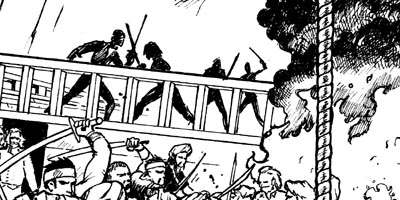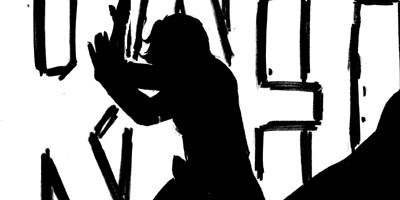No, you haven’t accidentally mis-clicked on an article for Cracked.com. This is still Mightygodking.com, even if I’m not him and I’m totally stealing a gimmick from Cracked’s lists (that are more like crack than Cracked, honestly. Once you start clicking on them, it’s five hours of timesink before you know it.) Because let’s face it: Lists, especially non-comprehensive lists that you can add onto yourself in the comments section, can be fun.
This time, it’s about film adaptations. We’ve entered a true golden age of film adaptations in some ways, especially when it comes to sci-fi/fantasy films; the improvements in effects technology, combined with the general viewing audience’s increasing familiarity with sci-fi tropes, has resulted in increasingly sophisticated and effective adaptations that bring the book (or comic book) to life. But sometimes, I find myself wondering if “faithful” should really be the defining quality of an adaptation. Sometimes, what works for a book doesn’t work for a movie, and vice versa. By way of counter-example, here are five films that changed a lot, but still made excellent movies.
5. Blade Runner. This one is low on my personal list because, despite it being a beloved cult film that influenced a generation of movie-makers, I really don’t care for it. I’ve watched the theatrical cut, the director’s cut, pretty much every cut they put out, and it always feels like a slow, shapeless mess that wastes Harrison Ford’s talents as an actor (or, arguably, where Harrison Ford wastes his own talents as an actor–Ford can be brilliant, but you can tell when he’s not emotionally invested in a project, and he clearly sleepwalks through this one.) But I’m aware that it is much adored by a great many people, and I can appreciate that even if I don’t share it.
And to the extent that it is good, it’s good specifically because it abandons Dick’s original novel; “Do Androids Dream of Electric Sheep?” never really looks at the moral ambiguity present in the Replicants, instead taking the claim that they lack empathy at face value. “Blade Runner” admits the flaw in this entire concept, questioning the morality of gunning down people who look human, act human, and may in fact be more human than human. In fact, I’d say that the less faithful an adaptation of this novel is, the better it could be. (Witness “The Wedding Banquet”, which abandons every single aspect of the novel and is absolutely charming. 🙂 )
4. The Collector. This is an interesting one, because in terms of plot, it’s totally faithful to the original novel…but the original novel was absolutely unadaptable in its existing form. For those of you who haven’t read it, it’s a story about a kidnapping told first from the perspective of the kidnapper, then from the perspective of the victim, then returning to the kidnapper’s point of view for the finale. The narration manages the almost impossible trick of making you understand the motives of the kidnapper and even sympathize with him at times (the victim’s POV scenes make her out to be every bit as snooty as the kidnapper’s persecution complex imagines her to be)…right before hitting you in the gut with the final sequences.
The film adaptation doesn’t have the ability to do any of that. But with nothing more than a tiny bit of voice-over narration, it still conveys that same sensibility, solely through the acting talents of Terrance Stamp. His body language and facial expressions convey everything that the film can’t show in other ways, and Samantha Eggar strikes just the right note of ambiguity as the victim (it helps that Eggar shot Stamp down for a date when they were at college. Nothing says awkward like actual awkwardness.)
3. Memento. I’m going to try not to gush here, but…the original short story was a very clever idea, expertly presented in an artfully precise short story. Christopher Nolan then took that idea and used it as the seed for a chillingly brilliant film that explores the nature of revenge in a way that almost no Hollywood movie ever does. Seeing that final/first scene, and realizing where Leonard’s quest for revenge has taken him, is a moment far more powerful than any of the various “Death Wish” clones out there ever deliver. Lots of films talk about how revenge is ultimately hollow, but they usually do that as an obligatory wrist-slap after the hero gets heaping helpings of juicy, delicious revenge that we can vicariously enjoy. “Memento” radically departs from that model (which is equally present in the original short story) and is all the better for it.
2. The Princess Bride. I actually read the book before I saw the movie, and I remember watching the whole thing in a state of constant, low-grade dread because I knew how the book ended. I know there will always be purists who feel that the original, unhappy ending is somehow “truer” (I hear the same thing a lot about “The Little Mermaid”, too) but I think that sometimes we need a little bit of fairy-tale in our life. We need happy endings in stories precisely because we don’t get them very often anywhere else, and I don’t think there’s anything wrong with wanting them. And “The Princess Bride” is just an unabashedly beautiful film with plenty of heartfelt moments (I defy anyone in the world not to shed a tear the first time they hear Inigo say, “I want my father back, you son of a bitch.” It’s not exactly a “Memento”-level commentary on the hollowness of revenge, but it gets the point across.) Most interestingly, this is a rare case where the writer and the adapter are one and the same person; William Goldman was undoubtedly proud of his novel, but he wasn’t afraid to kill his children if it resulted in a good movie, and “The Princess Bride” is one of the best.
1. Who Framed Roger Rabbit? If you’ve never read “Who Censored Roger Rabbit?”, the novel that formed the basis for the film, let me save you some time: Don’t. It’s downright inept, a muddled murder mystery full of red herrings and an ending that comes so far out of left field that you might legitimately suspect it to be from another ballpark. But somehow, Jeffrey Price and Peter Seaman managed to throw away the gallons of bathwater and still keep the baby. Almost nothing remains of the original save the barest bones of the central concept–“Toons”, a private detective, and a murder–but those elements make the story what it is. Every change improves the story, and they’re all done with a keen, aggressive eye towards making it all click with audiences. If you ever want to run a clinic on how to rewrite a book into a movie, this would form a core part of the curriculum.
So that’s my five…or at least, five of my many. As always, feel free to add yours in the comments section!




